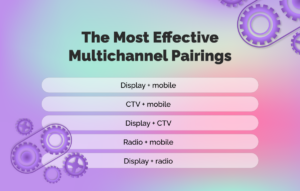If your business isn’t using retargeting ads yet, you’re leaving money on the table — and probably falling behind your competitors. In fact, retargeted users are 70% more likely to convert than first-time website visitors, so this is a digital marketing strategy well worth investing in.
Programmatic retargeting leverages data-driven insights and automation to help you nurture warm leads who have shown interest in your products or services but have not yet made a purchase. An effective retargeting strategy can increase brand recall, boost conversions and ROI, and enhance customer engagement.
Today, we’re going to walk you through a four-step process for creating a successful programmatic retargeting campaign and share our three top tips for maximizing campaign effectiveness.

How to Create a Successful Retargeting Campaign in 4 Easy Steps
1. Set Your Campaign Objectives
Start by thinking about what you want to achieve with your retargeting campaign. Are you aiming to increase sales, generate leads, promote brand awareness, or encourage customer loyalty? Clearly defining your purpose will guide your strategy and ensure every decision and action aligns with your overarching objectives.
Once you’ve established the purpose of your campaign, you’ll need to decide the best way to measure the outcomes and analyze its success. For example, you might aim to achieve a certain percentage increase in website conversions or a specific return on ad spend (ROAS) within a designated time frame. This data allows you to track progress, assess performance, and make data-driven adjustments as necessary.
Some of the metrics you can use to measure campaign performance include:
- ROAS
- Revenue
- View Through Conversions
- Conversion Rate
- Click-Through Rate (CTR)
Retargeting ad campaigns target users who have already taken action — whether it’s visiting your website, looking at a specific product page, or sharing their contact information. Therefore, you’ll need to think about how to align your retargeting campaign with marketing efforts across all channels.
For instance, are there other channels in your campaign that could support or align with your programmatic retargeting objectives? By integrating your retargeting goals with your broader marketing strategy, you can ensure a cohesive and consistent brand experience for your retargeting audience across all touchpoints. This alignment maximizes the effectiveness and impact of your programmatic retargeting campaign.
2. Segment Your Retargeting Audience
A retargeting audience is a collection of users who have taken a specific website action, so segmentation depends on behavior rather than demographics. For instance, you’ll want to segment users who fill in a contact form separately from those who leave abandoned carts, as each audience will respond differently to your messages.
Segmenting your retargeting audience by behavior will enable you to create personalized retargeting ads that will increase the effectiveness of your campaign. Here are a few examples of ways you can segment your retargeting audience:
- You can track anyone who visits your website and create a large retargeting audience of all those people.
- You can track visits to a specific page — or pages — and create a separate retargeting audience for visitors of just that page.
- You could also create a separate retargeting audience of users who added items to their cart but did not check out (cart abandons).
- If you want existing customers to return, you can create a retargeting audience of people who have completed a purchase.
- If your website contains interactive content, such as call-to-action (CTA) buttons, gated content, or videos, you may want to segment retargeting audiences based on actions such as button clicks, downloads, or video plays.
3. Analyze Audience Behavior and Preferences
Collect relevant data on user behavior and preferences through various sources, such as website analytics, CRM systems, or tracking pixels. This information provides valuable insights into how your audience interacts with your brand and allows you to make data-driven decisions that improve your campaign’s effectiveness. With programmatic, you can access this data in real-time and optimize the campaign while it’s still running for maximum impact.
Analyze the collected data to identify patterns and trends in audience behavior and look for commonalities among certain segments that can help you understand their preferences, motivations, and pain points.
4. Optimize and Improve Your Campaign
Continue to monitor and analyze audience behavior to refine your retargeting strategy. Leverage your data insights to optimize your messaging, ad placements, or targeting parameters to align more effectively with your audience’s preferences. This will improve campaign performance and results.

3 Tips for Designing an Effective Retargeting Campaign
1. Craft Compelling Retargeting Messages
Personalized messages resonate with users and make them more likely to complete their abandoned purchases, sign up for newsletters, or take other desired actions, resulting in higher conversion rates. They also enhance brand perception, build trust, and foster a sense of connection and loyalty among your target audience.
Compelling retargeting messages speak to the audience segment according to where they are in their buyer’s journey. Think about the pain points specific parts of your audience may have — for instance, an abandoned cart may mean price is an issue, and you can offer that segment a discount on the product they’ve shown interest in.
Another way to address a retargeting audience is to highlight the benefits of your offer. For example, if you want people to subscribe to your newsletter, tell them what insights they will gain from it and how it will improve their business or make their life easier.
Always tailor your messaging according to the segment of the retargeting audience you’re focusing on. The messages for a first-time visitor should be more focused on top-of-funnel objectives, such as raising brand awareness, while bottom-of-funnel messages will be more sales oriented. In general, the aim of retargeting messages is to serve as a reminder, prompt users to return to your website, or offer customers a new product after they’ve completed a purchase.
2. Select the Right Channels and Platforms
Programmatic ads can be deployed across a variety of channels to maximize the number of touchpoints and increase impact. Some of the main programmatic channels include:
- Display ads
- Video ads
- Audio ads
- Programmatic Digital Out-of-Home (pDOOH)
- Mobile and in-app ads
- Connected TV (CTV) ads
By analyzing your audience data, you can identify their behavior, preferences, and the channels where they’re most active so you can focus your retargeting efforts there. For example, if the majority of your retargeting audience frequently listens to podcasts, audio ads would be a wise addition to your media mix.
If you decide to use multiple channels for your retargeting strategy, you’ll want to consider which channels work best together. A report by Media Post found that some of the most effective multichannel pairings include:
- Display + mobile
- CTV + mobile
- Display + CTV
- Radio + mobile
- Display + radio
When designing multichannel campaigns, you’ll also need to think about how each channel can complement the other — while the messaging should be consistent and on-brand, you’ll need to adapt it to each channel.
However, you should beware of ad fatigue, which can have the opposite of the desired effect. Limit the number of ads per user to around 20 per month and continue to revisit this number based on campaign analytics.

3. Test, Optimize, and Repeat
Continuous testing and optimization will help you improve the effectiveness of retargeting campaigns over time, as constantly experimenting and making data-driven adjustments allows you to refine your strategies and achieve better results. Testing and optimization enable you to adapt to changing audience behaviors and market dynamics, maximizing the impact of your retargeting efforts.
One of the most popular testing methods is A/B testing, which involves creating multiple variations of retargeting ads and comparing their performance. You can test different elements — such as messaging, visuals, CTAs, or ad formats — to identify the most effective combinations. This helps you understand what resonates with your audience, enabling you to optimize your ads for better engagement and conversion rates.
Another way to test and optimize your campaigns is through iterative improvement based on performance analysis of key metrics and data. Use these insights to identify strengths, weaknesses, and areas of improvement and inform iterative changes. These changes may include refining targeting parameters, messaging, or ad placements to continuously improve campaign effectiveness and ROI.
Grow Your Business with Programmatic Retargeting
Programmatic campaigns are one of the most efficient ways to maximize the impact of your retargeting efforts. However, programmatic advertising requires specialist knowledge and expertise to truly be effective.
The Grapeseed team of programmatic experts has created Grape Bot — our proprietary chatbot specializing in all things programmatic — to help you deepen your knowledge and answer your most burning questions.
To chat with Grape Bot about retargeting or any other aspect of programmatic advertising, click on the chat button at the bottom right of this post. Or, if you prefer the human touch, reach out to the Grapeseed team — we’ll be happy to assist you.






